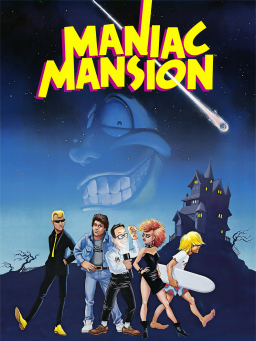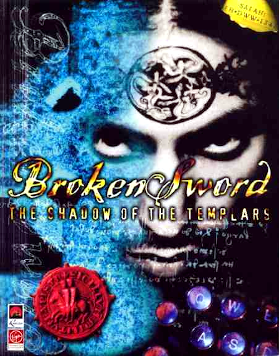
Maniac Mansion is a 1987 graphic adventure video game developed and published by Lucasfilm Games. It follows teenage protagonist Dave Miller as he attempts to rescue his girlfriend Sandy Pantz from a mad scientist, whose mind has been enslaved by a sentient meteor. The player uses a point-and-click interface to guide Dave and two of his six playable friends through the scientist's mansion while solving puzzles and avoiding dangers. Gameplay is non-linear, and the game must be completed in different ways based on the player's choice of characters. Initially released for the Commodore 64 and Apple II, Maniac Mansion was Lucasfilm Games' first self-published product.

Script Creation Utility for Maniac Mansion (SCUMM) is a video game engine developed at Lucasfilm Games, later renamed LucasArts, to ease development on their graphic adventure game Maniac Mansion (1987). It was subsequently used as the engine for later LucasArts adventure games and Humongous Entertainment games.

Script Creation Utility for Maniac Mansion Virtual Machine (ScummVM) is a set of game engine recreations. Originally designed to play LucasArts adventure games that use the SCUMM system, it also supports a variety of non-SCUMM games by companies like Revolution Software and Adventure Soft. It was originally written by Ludvig Strigeus. ScummVM is free software that is released under the terms of the GNU General Public License.

Beneath a Steel Sky is a 1994 point-and-click adventure game developed by British developer Revolution Software and published by Virgin Interactive Entertainment for MS-DOS and Amiga home computers. It was made available as freeware – and with the source code released – for PC platforms in 2003. Set in a dystopian cyberpunk future, the player assumes the role of Robert Foster, who was stranded in a wasteland known as "the Gap" as a child and adopted by a group of local Aboriginals, gradually adjusting to his life in the wilderness. After many years, armed security officers arrive, killing the locals and taking Robert back to Union City. He escapes and soon uncovers the corruption which lies at the heart of society.

Revolution Software Limited is a British video game developer based in York, founded in 1989 by Charles Cecil, Tony Warriner, David Sykes, and Noirin Carmody.
Broken Sword is a series of adventure games. The first game in the series, Broken Sword: The Shadow of the Templars, was released and developed in 1996 by British developer Revolution Software. Its sequel, Broken Sword II: The Smoking Mirror, was released a year later, and was followed by Broken Sword: The Sleeping Dragon in 2003, Broken Sword: The Angel of Death in 2006, and Broken Sword 5: The Serpent's Curse in 2013. A remake of the first game in the series, known as Broken Sword: Shadow of the Templars – The Director's Cut, was released in 2009, and a remake of the second game in the series, Broken Sword: The Smoking Mirror – Remastered, in 2010 for iOS devices; other platforms followed in 2011.
The Adventure Game Interpreter (AGI) is a game engine developed by Sierra On-Line. The company originally developed the engine for King's Quest (1984), an adventure game that Sierra and IBM wished to market in order to attract consumers to IBM's lower-cost home computer, the IBM PCjr.

Cruise for a Corpse is an adventure game from Delphine Software International, made for the Amiga, Atari ST and IBM PC.

Conquests of the Longbow: The Legend of Robin Hood is a graphic adventure game designed by Christy Marx and published by Sierra On-Line in 1991. It is the second and final part of the Conquests series, which begins with Conquests of Camelot: The Search for the Grail. It features VGA graphics and Sierra's standard icon-driven interface first seen in King's Quest V.

Flight of the Amazon Queen is a graphical point-and-click adventure game by Interactive Binary Illusions, originally released in 1995 for Amiga and MS-DOS. The game was re-released as freeware in 2004 for use with ScummVM. In January 2022, a sequel was announced, titled Return of the Amazon Queen.
Simon the Sorcerer is a series of point-and-click adventure games created by British developer Adventure Soft. The series follows the adventures of an unwilling hero of the same name and has a strong fantasy setting similar to Sierra's King's Quest and Westwood's The Legend of Kyrandia series. The game varies in style, however, as it is more poised to be a parody of the fantasy genre than a member of the genre itself, with many renowned folklore characters appearing differently from what they are generally presumed to be.

The Virtual Theatre is a computer game engine designed by Revolution Software to produce adventure games for computer platforms. The engine allowed their team to script events, and move animated sprites against a drawn background with moving elements using a point-and-click style interface. Upon its first release, it rivaled competing engines like LucasArts' SCUMM and Sierra's Creative Interpreter, due to its then high level of artificial intelligence. The engine was first proposed in 1989, while the first game to use it, Lure of the Temptress, was released in 1992, followed by Beneath a Steel Sky (1994), Broken Sword: The Shadow of the Templars (1996) and Broken Sword II: The Smoking Mirror (1997).

Charles Cecil is a British video game designer and co-founder of Revolution Software. His family lived in the Democratic Republic of the Congo when he was still very young, but was evacuated two years after Mobutu Sese Seko's coup d'état. He studied at Bedales School in Hampshire, England. In 1980 he began his studies in Engineering Manufacture and Management at Manchester University, where he met student Richard Turner who invited him to write text adventures for Artic Computing. After completing his degree in 1985 he decided to continue his career in game development and became director of Artic. The following year he established Paragon Programming, a game development company working with British publisher U.S. Gold. In 1987 he moved into publishing as a software development manager for U.S. Gold. A year later he was approached by Activision and was offered the position of manager of their European development studio.

King's Quest VI: Heir Today, Gone Tomorrow is a point-and-click adventure game, first released in 1992 as the sixth installment in the King's Quest series produced by Sierra On-Line. Written by Roberta Williams and Jane Jensen, King's Quest VI is widely recognized as the high point in the series for its landmark 3D graphic introduction movie and professional voice acting. King's Quest VI was programmed in Sierra's Creative Interpreter and was the last King's Quest game to be released on floppy disk. A CD-ROM version of the game was released in 1993, including more character voices, a slightly different opening movie and more detailed artwork and animation.

There have been several video games based on the 1991 film Hook. A side-scrolling platform game for the Nintendo Entertainment System (NES) and Game Boy was released in the United States in February 1992. Subsequent side-scrolling platform games were released for the Commodore 64 and the Super Nintendo Entertainment System (SNES), and an arcade beat ‘em up by Irem later in 1992, followed by versions for the Sega CD, Sega Genesis, and Sega's handheld Game Gear console in 1993.

Broken Sword: The Shadow of the Templars is a 1996 point-and-click adventure game developed by Revolution Software. It is the first in the Broken Sword series, co-written and directed by Charles Cecil. The player assumes the role of George Stobbart, an American tourist in Paris, as he attempts to unravel a deep conspiracy involving a sinister cult and a hidden treasure, seeing him travel to various locations around Europe and the Middle East. The game's storyline was conceived to feature a serious tone and heavily influenced by research on Knights Templar by Cecil, but was also interlaced with humor and graphics in the style of classic animated films.

Curse of Enchantia is a graphic adventure game developed and released by the British video game company Core Design for MS-DOS and the Amiga in 1992. The game tells the comic fantasy story of Brad, a teenage boy from modern Earth who was magically abducted to the world of Enchantia by an evil witch-queen. He needs to escape and find a way back to his own dimension.

Tony Warriner is a British video game designer, programmer and co-founder of Revolution Software. At a young age he started playing adventure games, when they were just text adventures. He wrote his first game, Obsidian, while he was at school and sent it to Artic Computing for consideration. Artic's director, Charles Cecil, loved the game and convinced him to license it to Artic, and then to join Artic as a programmer. At Artic he wrote, together with Adam Waring, Ultima Ratio which was published in 1987 by Firebird. In the same year he got a job at Cecil's Paragon Programming, where games from US publishers were converted to European platforms. When Cecil had left to work for U.S. Gold, Warriner started doing 8-bit programming for games. In 1988 he created Death Stalker, published by Codemasters. In the same year he joined Cascade Games, where he worked on 19 Part One: Boot Camp, Arcade Trivia Quiz, and Arcade Trivia Quiz Question Creator. In 1989 Warriner moved to Bytron Aviation Systems based in Kirmington, Lincolnshire, where he wrote software for the aviation industry, David Sykes was his fellow programmer.

The Immortal is an isometric action-adventure game originally created by Will Harvey and released by Electronic Arts in 1990 for the Apple IIGS. It was soon ported to the Amiga, Atari ST, DOS, Nintendo Entertainment System, and Genesis. A wizard is attempting to find his mentor in a large and dangerous labyrinth. It has a high degree of graphic violence. In 2020, the NES port was re-released on the Nintendo Switch Online service, while the Genesis port was re-released on the Piko Collection Collection 1 cartridge for the Evercade.

Nippon Safes Inc. is a point-and-click adventure game developed by Italian developer Dynabyte. It was released in 1992 for MS-DOS and Amiga computers. The game is the predecessor to The Big Red Adventure and features cartoonish, comics-style graphics and a unique icon-based interface. In 2021 the game was declared freeware by the original authors of the game.


















